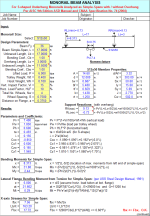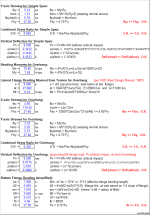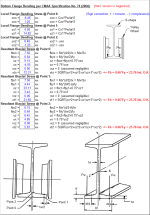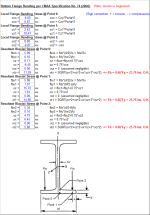MONORAIL.xls
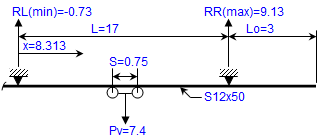
Description
"MONORAIL.xls" is a MS-Excel spreadsheet program for analysis of
beam end connections using a tab plate per AISC 9th Edition (ASD).
There is one worksheet for S-shaped monorial beams and another
worksheet for W-shaped monorail beams. Monorail beams are analyzed as
single-span beams with or without a cantilever (overhang). Torsional
effects are considered as well as bottom flange local bending using 2
different methods.
All the worksheets are independent and self contained, so that you can move them from one workbook to another. All the worksheets are protected, but not with a password.
Please read the "DOC" worksheet for program details as well as assumptions and limitations.
Calculation Reference
USS Steel Design Manual
AISC 9th Edition ASD Manual
CMAA Specification No. 74 (2004)
Calculation Preview
Full download access to any calculation is available to users with a paid or awarded subscription (XLC Pro).
Subscriptions are free to contributors to the site, alternatively they can be purchased.
Click here for information on subscriptions.
When the wheel spacing for 2-pairs of wheels is < 0.586*L the maximum moment is determined by M(max) = P*(L-S/2)^2/(2*L), and when the wheel spacing for 2-pairs of wheels is >= 0.586*L, the maximum moment is determined by M(max) = P*L/4. The preceding, of course, excludes the monorail beam self weight.
I did have the correct programming logic to differentiate between these 2 conditions for calculating the maximum moment. However, for the case where S >= 0.586*L, I inadvertently forgot to divide the value of "Pv" by 2 (where "Pv" represents the total of the lifted load + trolley weight + hoist weight), since 1-pair of wheels is actually off of the beam span and not considered for the purpose of analysis.
Thus, this error would result in an overly conservative maximum moment, by a factor of 2, for trolleys with 2-pairs of wheels. The fast majority of maintenance/service type monorails have wheel spacings which are normally far less than the 0.586*L value. However, while rare in occurrence or not, the corrections needed to be made to correctly address any situation.
With this error of using "L" instead of "Lo", the result from the calculation would have been conservative, but not nearly as much as one might expect. That is due to the fact that the formula used includes a hyperbolic function in the expression.....TANH(Lo*12/at).....where at = SQRT(E*Cw/(J*G)). When the value of (Lo*12/at) is >= say 3.0, the TANH of that approaches 1.0. Thus, the larger the overhang (cantilever) length was, the smaller the conservative error became. Plus, the error that was involved was a good bit less when using the more common "S" shapes as opposed to using "W" shapes for the monorail beam.
I have made the corrections and the new version of this workbook is now version 2.0.
At the bottom of the 2nd page of the calculations where bottom flange bending is checked via a simplified approach, the worksheets were originally taking the wheel load to be at the edge of the flange, which was conservative. Now the moment arm for bending has been reduced by subtracting the input distance "a" from the edge of the flange to the center of wheel.
In the 3rd page of the calculations where bottom flange bending is analyzed per CMAA Specification No. 74, the worksheets were using the originally computed bending stress values of "fbx" and "fby" (taken to the extreme outer edges) in the biaxial stress formulas for the analyzed point locations 0, 1, and 2. Again these values were in some cases conservative, depending on the point which was being investigated. Now the bending stress values "fbx" and "fby" are determined at the specific point under consideration (fbxo, fbx1, fbx2 and fbyo, fby1, fby2).
Off of the main calculation page to the right for the Y-axis stress ratio, the cell references in cells BB90, BB13, and BE13 were not using "fby(total)", only "fby", and thus were neglecting the stress contribution from torsion, "fwns".
Fortunately the logic statement in cell I90 on the 2nd page of the actual calculations was correct, in that it was using "fby(total)" in the calculation of the stress ratio, so the actual displayed and printed calculations were fine.
This problem occurred in both worksheets of the workbook, and I have made the corrections. The workbook is now version 1.8.
Specifically for the situation of a member with Lbo <= Lu and with an input value of Cbo < 1.0, the two worksheets were ignoring an input value of Cbo < 1.0, treating Cbo as if it were = 1.0, and thus deferring to Fb = 0.6*Fy. This problem involving the use of a Cbo value < 1.0 did not occur for Lbo > Lu.
Again, this potential problem would have only arisen if a value of Cbo < 1.0 was used from the Tanner article in conjunction with Lbo <= Lu.
The corrections have been made, and the updated workbook is now version 1.7.
Alex Tomanovich, P.E.
In the text display of the formula for the x-axis simple span moment (Mx) for a concentrated load at midspan, the text had both divide and multiply symbols between the variables "Pv" and "L/4". The divide symbol should not have been there. In the resultant biaxial stress at point 1 calculation, the text display of the formula for the z-axis stress showed sigma(y), when it should have been sigma(z). These typo errors occurred in both of the calculation worksheets, and they have been corrected in version 1.6.
total) I had inadvertently omitted the self weight of the monorail beam in the actual calculation of the strong axis bending moment, Mx. The monorail beam self weight was included in the actual moment calculation for the case of 1-pair of wheels (2 wheels total). The text displaying the formulas used for the moment were correctly shown for both cases, it was the calculation cell for that one case that was in error.
I'm somewhat puzzled at the nature of this error and how it happened, as I usually write out the logic/formula, copy that to the calculation cell, and then substitute the appropriate cell references for each of the variables in the logic/formula. I obviously must have gotten carried away with use of the backspace key during the editing process. It is updated to version 1.4.
Alex Tomanovich, P.E.
Senior Structural Engineer

